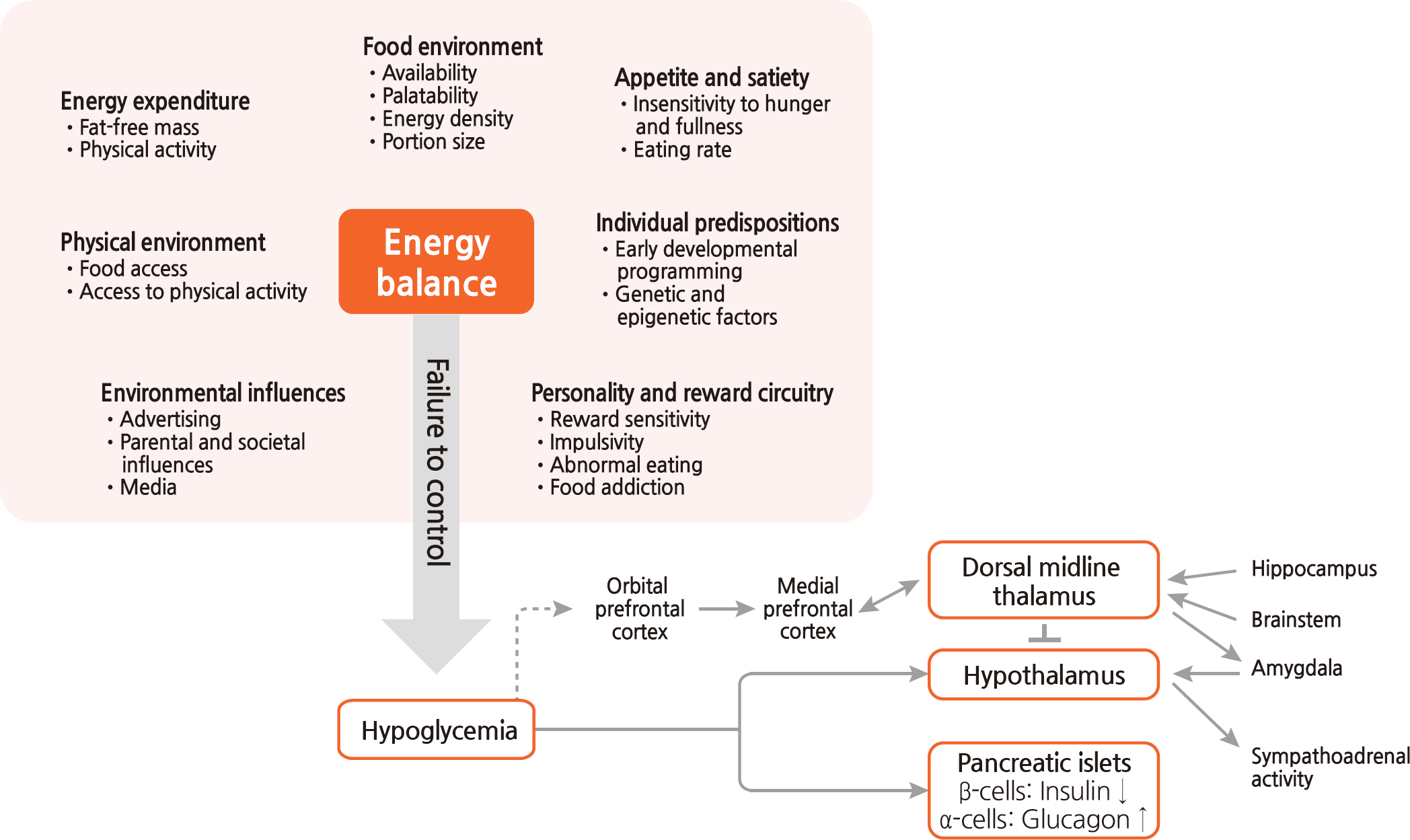J Korean Diabetes.
2016 Sep;17(3):147-154. 10.4093/jkd.2016.17.3.147.
A Noisy Carbohydrate Addiction
- Affiliations
-
- 1Division of Endocrinology and Metabolism, Soonchunhyang University Cheonan Hospital, Cheonan, Korea. waan@schmc.ac.kr
- 2Department of Internal Medicine, Inha University School of Medicine, Incheon, Korea.
- 3Department of Internal Medicine, Sejong General Hospital, Bucheon, Korea.
- 4Department of Endocrinology and Metabolism, Seonam University, Myongji Hospital, Goyang, Korea.
- 5Division of Endocrinology and Metabolism, Department of Medicine, Kyung Hee University Hospital at Gangdong Kyung Hee University School of Medicine, Seoul, Korea.
- 6Department of Endocrinology and Metabolism, Kyung Hee University School of Medicine, Seoul, Korea.
- 7Department of Internal Medicine, Chonnam National University Medical School, Gwangju, Korea.
- KMID: 2354277
- DOI: http://doi.org/10.4093/jkd.2016.17.3.147
Abstract
- Carbohydrates are a primary source of energy and a major component of the structure of living things-; there are many different kinds. As eating behavior is a part of life, it was usually not described in addiction. However, sometimes it seems aspects of addiction. This eating behavior can also appear with regard to other food. A bio-psycho-social model is required for complex analysis of addiction. When highly addictive agents are excluded, we can usually identify a key factor related to the vulnerability of the individual to addictive behavior. Considering that every source of happiness can potentially lead to addictive behaviors, we need to be cautious about the controlling. Not every carbohydrate can be connected with addictive behavior. Addictive behavior could be associated with a variety of ingredients other than carbohydrates. Until recently, sweet substances were thought to be the primary culprit behind addictive behavior. It is necessary to identify the food component or other factors associated with a specific craving. A multidimensional approach to the psychology of addictive behaviors might be more useful than opposing carbohydrate consumption in general.
Keyword
MeSH Terms
Figure
Reference
-
References
1. Baynes J, Dominiczak MH. Medical biochemistry. 4th ed.Philadelphia: Saunders;2014. p21.2. Davis C, Carter JC. Compulsive overeating as an addiction disorder. A review of theory and evidence. Appetite. 2009; 53:1–8.
Article3. Arlington VA. American Psychiatric Association. Diagnostic and statistical manual of mental disorders. 5th ed.Washington DC: American Psychiatric Association;2013.4. Martin KA, Mulder JE. Obesity in adults: behavioral therapy. Available from:. http://www.uptodate.com/contents/whats-new-in-endocrinology-and-diabetes-mellitus. (updated 2015 Apr 27).5. Schultz W. Neuronal reward and decision signals: from theories to data. Physiol Rev. 2015; 95:853–951.
Article6. Ziauddeen H, Farooqi IS, Fletcher PC. Obesity and the brain: how convincing is the addiction model? Nat Rev Neurosci. 2012; 13:279–86.
Article7. US Department of Agriculture, Agricultural Research Service, Nutrient Data Laboratory. USDA National Nutrient Database for Standard Reference, Release 28. Available from:. https://www.ars.usda.gov/northeast-area/beltsville-md/beltsville-human-nutrition-research-center/nutrient-data-laboratory/docs/sr28-download-files/. (updated 2016 May).8. Krashes MJ, Lowell BB, Garfield AS. Melanocortin-4 receptor-regulated energy homeostasis. Nat Neurosci. 2016; 19:206–19.
Article9. Holt RIG. Textbook of diabetes. 4th ed.Chichester: Wiley;2010. p535.10. Garfield AS, Shah BP, Madara JC, Burke LK, Patterson CM, Flak J, Neve RL, Evans ML, Lowell BB, Myers MG Jr, Myers MG Jr, Heisler LK. A parabrachial-hypothalamic cholecystokinin neurocircuit controls counterregulatory responses to hypoglycemia. Cell Metab. 2014; 20:1030–7.
Article11. Kim YR, Cho SH, Moon JJ. Addictive aspects of eating disorders and obesity. J Korean Neuropsychiatr Assoc. 2012; 51:36–44.
Article12. American Diabetes Association. 3. Foundations of care and comprehensive medical evaluation. Diabetes Care. 2016; 39(Suppl 1):S23–35.13. Hussain S, Richardson E, Ma Y, Holton C, De Backer I, Buckley N, Dhillo W, Bewick G, Zhang S, Carling D, Bloom S, Gardiner J. Glucokinase activity in the arcuate nucleus regulates glucose intake. J Clin Invest. 2015; 125:337–49.
Article14. Blum K, Thanos PK, Gold MS. Dopamine and glucose, obesity, and reward deficiency syndrome. Front Psychol. 2014; 5:919.
Article15. Wikipedia. Sweetener. Available from:. https://commons.wikimedia.org/wiki/Category:Sweeteners. (updated 2014 Apr 8).16. Berridge KC, Kringelbach ML. Pleasure systems in the brain. Neuron. 2015; 86:646–64.
Article17. Ochoa M, Lallès JP, Malbert CH, Val-Laillet D. Dietary sugars: their detection by the gut-brain axis and their peripheral and central effects in health and diseases. Eur J Nutr. 2015; 54:1–24.
Article18. Joyner MA, Gearhardt AN, White MA. Food craving as a mediator between addictive-like eating and problematic eating outcomes. Eat Behav. 2015; 19:98–101.
Article19. Spring B, Schneider K, Smith M, Kendzor D, Appelhans B, Hedeker D, Pagoto S. Abuse potential of carbohydrates for overweight carbohydrate cravers. Psychopharmacology (Berl). 2008; 197:637–47.
Article20. Russo SJ, Nestler EJ. The brain reward circuitry in mood disorders. Nat Rev Neurosci. 2013; 14:609–25.
Article21. Reas DL, Grilo CM. Pharmacological treatment of binge eating disorder: update review and synthesis. Expert Opin Pharmacother. 2015; 16:1463–78.
Article
- Full Text Links
- Actions
-
Cited
- CITED
-
- Close
- Share
- Similar articles
-
- Biological Model and Pharmacotherapy in Internet Addiction
- A Study on the Relationship and Co-Occurrence of Keywords Related to Alcohol, Nicotine, and Behavioral Addictions
- Effects of a Prevention Program for Media Addiction on Television Addiction, Internet Addiction, Cellular Addiction, and Impulsiveness in Elementary School Students
- Relationship between Adolescent Internet Addiction Tendency and Family Environment
- Internet Addiction, Social Support and Psychological Factors in Adolescents


